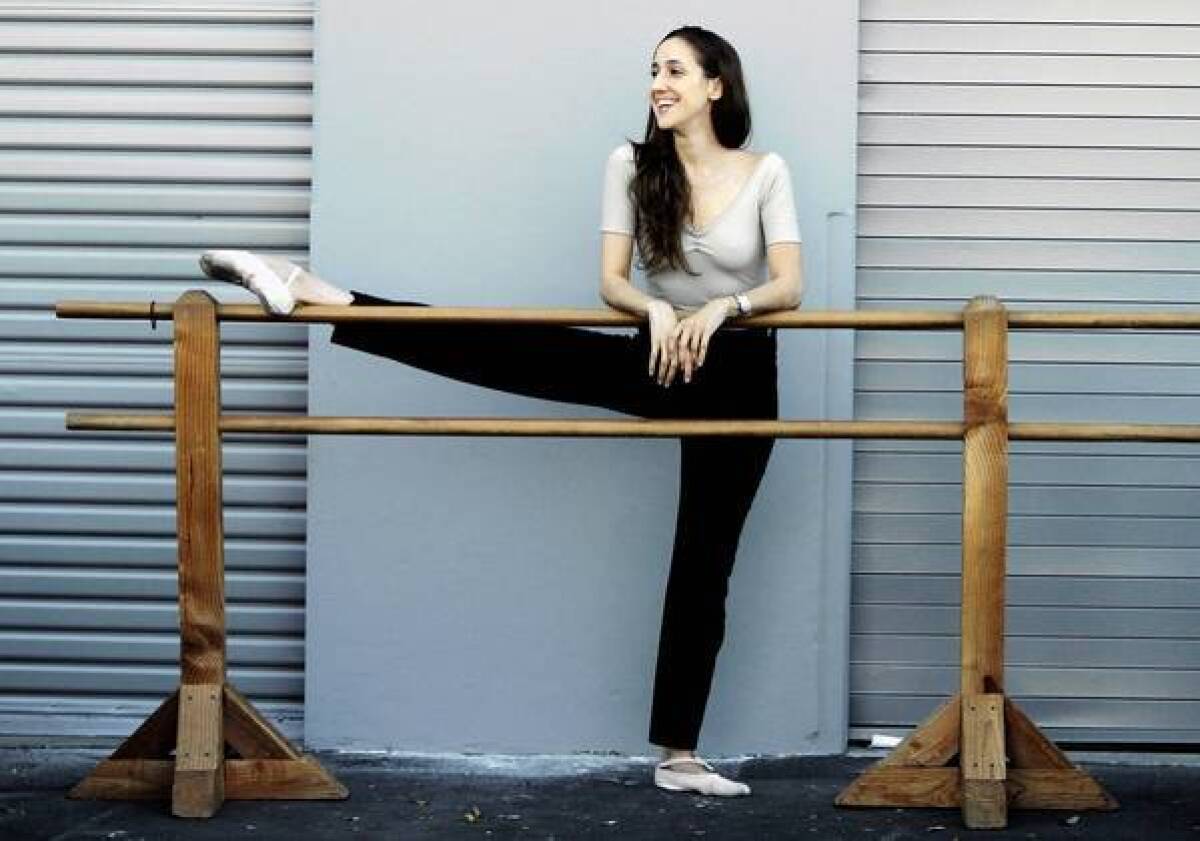Barak Ballet ready to leap into the dance world

Pushing herself across the floor in a slow crawl, her face in searching mode, back slightly arched, she resembles an Andrew Wyeth “Helga” painting. But this is no artist’s model, nor a trained modern dancer. This is Melissa Barak, a Los Angeles native who made a name for herself with New York City Ballet first as a ballerina, then beginning in 2002 as a choreographer, with the New York Times writing, “Barak’s gift is for exploring pure movement.”
And though she hasn’t been onstage in two years, Barak, 34, says she felt it “appropriate” to be part of Barak Ballet’s inaugural performance at Santa Monica’s Broad Stage on Oct. 24. Two years in the making (with a pre-launch performance last March), the 17-member company presents “L.A. Moves,” a concert featuring two Barak premieres, a contemporary work by former Graham dancer Pascal Rioult, and Barak’s solo, made for her by Danielle Agami, artistic director of the recently transplanted troupe, Ate9.
FOR THE RECORD:
Melissa Barak: An Oct. 20 article about dancer Melissa Barak cited Andrew Wyeth’s “Helga” paintings. The reference should have been to Wyeth’s “Christina” paintings. —
“People know me as a dancer,” said Barak during a rehearsal break at Westside School of Ballet, “and I also wanted to work with Danielle. I knew she was going to open my mind and body, as a dancer and choreographer. It’s been challenging, because I don’t feel like I’m in my artistic element, and I’m excited, but it’s also a little scary.”
A savvy mix of contemporary dance and neoclassical ballet, the program also features 12 musicians from the Malibu Coast Chamber Orchestra, another way Barak hopes to boost the fledgling company’s profile in an unforgiving arts landscape.
“Live music adds drama for the dancers and for the audience,” said Barak, her facial features Modigliani-thin. “People are creating all the art you’re seeing and listening to — it’s a zing of energy.”
The erstwhile ballerina also wanted to tap local talent; her two new ballets (both performed en pointe) feature scores by L.A. composers. “Lux Aeterna” for four couples is about life cycles. Set to music of Maria Newman, daughter of the late film composer Alfred Newman, the Baroque-like work has dancers making bold entrances and exits to soaring strings. Barak’s “For Two,” is accompanied by music of Mario Grigorov, whose soundtracks are heard in three Lee Daniels films, including “Precious.” A former Batsheva dancer, Agami crafted Barak’s eight-minute solo to a commissioned score by Jodie Landau.
CHEATSHEET: Fall arts preview 2013
Agami, 28, also choreographed the dance element for the Industry’s latest opera, “Invisible Cities” (running at Union Station). She said working with Barak has been inspiring.
“The question is, ‘How do I break the way she thinks? How do I change her mind about how she’s moving?’ That’s the psychology I was investing in, and the solution was to use the floor.”
Agami also teaches Ohad Naharin’s Gaga technique. A kind of corporeal multi-tasking, Gaga is a way to both train the body and gain self-awareness by responding to verbal cues (“See if you can swim with your bones inside of your skin...”), a method that decidedly helped Barak.
“What turns me on is to create movement, to create form, to create composition. My tool to explain the sensation is images, something dancers can connect in their brains, their bodies, to something they know. I did this with Melissa,” Agami said.
And though ballet is about defying gravity, modern dance involves being rooted to the floor. Rioult, 59, who founded his eponymous troupe in 1994, created the partly World War II-inspired “Wien” for six dancers in 1995, setting it to Ravel’s “La Valse” (heard on tape).
PHOTOS: Arts and culture in pictures by The Times
Said Rioult by phone from New York: “It’s based on people being dragged down, pushed down by the weight of things, and on the idea of circling. The dancers rarely lose contact with the ground, which is something different for a ballet dancer. The piece is violent, but the violence comes mostly from the movement — how relentless and physical it is. It’s a hard piece to dance.”
Seth Belliston, 38, performed with Pacific Northwest Ballet for seven seasons. No stranger to bare feet, dancing in “Wien” posed challenges. “All the musical and choreographic complexities, working in tandem and opposition, make the piece difficult and intellectual since the structure is both cyclical and circular.”
Belliston, who first met Barack in 2001, danced with the troupe last March. He said he’s thrilled to be on the ground floor of Barak Ballet. “It’s awesome to see Melissa pulling this together in such an intelligent way — going slow and steady — so it can evolve and be stronger, bigger and more visible.”
Barak too is optimistic. “If we let this company organically develop, do good work, and people embrace it, we’ll see where the journey goes.”
More to Read
The biggest entertainment stories
Get our big stories about Hollywood, film, television, music, arts, culture and more right in your inbox as soon as they publish.
You may occasionally receive promotional content from the Los Angeles Times.










